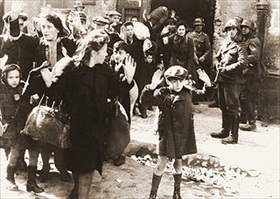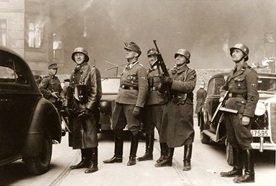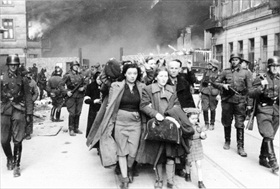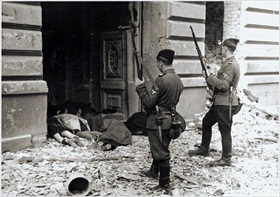WARSAW GHETTO RESIDENTS STAGE REVOLT
Warsaw, Occupied Poland • April 19, 1943
In October 1940, a little over a year after Nazi Germany’s conquest of its eastern neighbor Poland, German Governor-General Hans Frank established a Jewish ghetto in Poland’s capital, Warsaw, moving some 90,000 Jews from all over Poland into the ghetto. (Poland’s Jewish community numbered 3.5 million at the time.) The largest of the ghettos in Poland, the Warsaw Ghetto occupied a tiny section of the city, just 3.5 sq. miles/9 sq. kilometers (2 percent of the city’s area), but it contained 30 percent of the city’s population.
Initially gates allowing entry and exit were guarded by a mixed force of Germans, Poles, and Jews. Then on November 16, 1940, the Germans permanently sealed off the ghetto from the rest of the capital, first with barbed wire and wooden fences, then with 11‑ft-/3.4‑meter high brick walls topped with broken glass. No longer were residents allowed to leave the ghetto even for work. Hunger, disease (especially typhus), and overcrowding were endemic: each apartment building in the ghetto housed on average 400 people, and each room crammed with 6 or 7 people. No fresh fruits, vegetables, meat, fish, or milk were delivered from the outside. Food allocations, distributed through the ghetto’s Judenrat (Jewish Council) were roughly 200 calories per day per person. “Natural wastage” (natuerliche Personalreduzierung) was the German euphemism for this hideously slow death.
Over several months, in a massive set of deportations known as Gross-Aktion Warschau (July 23 to September 12, 1942), some 300,000 out of 350,000 ghetto residents were sent 60 miles/97 kilometers to the northeast of the capital, to the Treblinka death camp. (Treblinka was 1 of 6 death camps established on Polish soil. The others were Auschwitz-Birkenau, Chełmno [Kulmhof], Bełżec, Sobibór, and Majdanek.) In January 1943 Jewish resistance groups—principally Zydowska Organizacja Bojowa and Zydowski Zwiazek Wojskowy, whose weapons were supplied by the non-Jewish Polish underground Home Army (Armia Krajowa)—repulsed German troops sent to deport more ghetto residents. When the Germans entered the ghetto again on this date, April 19, 1943—coincidentally the first day of Passover—resistance flowered into a full-scale rebellion—the Warsaw Ghetto Uprising. Poorly armed Jews fought 2,000 tank-supported SS troops, who, while having a manpower and firepower advantage, were nonetheless stunned by the ferocity of the Jewish fighters. (The SS, short for Schutzstaffel, was a major paramilitary organization separate from the Germany Army. Under the command of Reichsfuehrer-SS Heinrich Himmler, it committed “crimes against humanity” and genocide, especially as directed toward Jews.)
The Germans and their Ukrainian auxiliaries initially withdrew from the ghetto after suffering 200 casualties. Despite impossible odds, ghetto residents held out against the enemy for close to a month. SS-Brigadefuehrer (Maj. Gen.) Juergen Stroop, the city’s police commander, ordered the systematic burning of the ghetto, house by house, street by street. Four weeks from the start of the uprising, Stroop was able to report to his superiors: “There is no more Jewish quarter in Warsaw.” Jewish survivors of the uprising were sent to either forced-labor camps or the Treblinka death camp. Treblinka is second only to Auschwitz-Birkenau in Jews murdered in Nazi death camps (900,000 vs. 1.5 million). Between deaths in camps and the uprising, at least 300,000 Warsaw Jews lost their lives during the Nazi period.
![]()
When I was offered the chance to adapt Irena’s story for children, I jumped on it. Irena’s choice to act, to resist power and evil at the risk of her life, not once, but day after day, made me want to be more courageous myself. Irena’s story proves we humans have great potential to put aside apathy and self-interest, to rise above hatred and fear, and to act with compassion in the darkest of days.
As the ghetto burned, she drew up a list of places throughout Warsaw, including her own apartment, where people agreed to hide Jews. With the Nazis hell-bent on destruction street-by-street, maybe Irena could sneak in once more, carrying the addresses of the safe houses. And if she could get in, surely she could get more children out.
The main thoroughfare to freedom was the sewer system. Irena mobilized her team of trusted men, women, and teenagers who had already rescued nearly 2,500 Jewish children. They scoured ghetto cellars convincing people to flee; they rushed into burning buildings and pulled out crying toddlers. Irena waited at sewer manholes sending escapees to safe addresses. The ruse worked for more than a week, families crawling through the sewers to safety. But when the German SS realized Jews were getting away, they shut off city utilities to the ghetto and pumped poison into the water and gas mains.
A short time later, Irena was betrayed to the Nazis. Arrested, tortured, and sentenced to death, she did not give up information. Irena’s Children: Young Readers Edition; A True Story of Courage tells how she escaped the firing squad moments before her execution.—Mary Cronk Farrell
![]()
Warsaw Ghetto Uprising, April 19 to May 16, 1943
 |  |
Left: Captioned “Forcibly pulled out of bunkers” (“Mit Gewalt aus Bunkern hervorgeholt”), this black-and-white photograph is among 52 submitted in an SS report by Juergen Stroop, Warsaw’s virulently anti-Semitic police chief, to Reichsfuehrer-SS Heinrich Himmler. Taken between April 19 and May 16, 1943, the photo is one of the best-known images from World War II. (Josef Blosche [far right, facing camera] earned the nickname “Frankenstein” by ghetto inhabitants due to his penchant for raping women and beating men.) Stroop kept a personal copy of the report (“Stroop-Bericht”), discovered at war’s end, in his home office in Wiesbaden, Germany. Stroop surrendered to the U.S. Army in May 1945, was extradited to Poland, tried in the Warsaw Criminal District Court in 1951, and hanged at Mokotów Prison on March 6, 1952.
![]()
Right: Guarded by troops armed with submachine guns, Stroop (center, in a field cap) and high-ranking SS officers watch ghetto apartments burn street by street. As Stroop put it in his report to Himmler, the intention of the blazes was to “smoke out the Jews and bandits.” About half of the 13,000 Jews who died in the Warsaw Uprising were burned alive or suffocated in their underground cellars, bunkers, and tunnels. Facilitating their annihilation were 1‑ and 2‑man portable flamethrowers (German, Flammenwerfer), critical in house-to-house fighting and as a means of implementing Germany’s “scorched earth” policy in the East, and for “reprisals.” Some 70,000 Flammenwerfer were produced during the war and dispersed to units of the Wehrmacht, SS, and police.
 |  |
Left: This photo in the “Stroop-Bericht” shows ghetto residents being led from a bunker where they had been hiding and marched to a transfer point (Umschlagplatz). There they would be sealed in freight cars with little water and poor ventilation and deported to death or labor camps.
![]()
Right: Two ex-Soviet POWs known as “Askaris” (Swahili, soldiers) in Hilfseinheiten (auxiliary units) used by the SS in suppressing the Warsaw Ghetto Uprising stare past the bodies of Jews killed during the monthlong revolt. Jews who resisted forcible deportation by hiding were often killed on the spot when discovered.
Warsaw Ghetto Uprising, 1943
![]()

 History buffs, there is good news! The Daily Chronicles of World War II is now available as an ebook for $4.99 on Amazon.com. Containing a year’s worth of dated entries from this website, the ebook brings the story of this tumultuous era to life in a compelling, authoritative, and succinct manner. Featuring inventive navigation aids, the ebook enables readers to instantly move forward or backward by month and date to different dated entries. Simple and elegant! Click
History buffs, there is good news! The Daily Chronicles of World War II is now available as an ebook for $4.99 on Amazon.com. Containing a year’s worth of dated entries from this website, the ebook brings the story of this tumultuous era to life in a compelling, authoritative, and succinct manner. Featuring inventive navigation aids, the ebook enables readers to instantly move forward or backward by month and date to different dated entries. Simple and elegant! Click 











